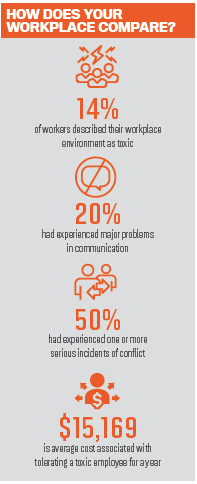Building a better team will save you time, money and stress

Building a better team will save you time, money and stress
Just listen to the conversations around you on public transport or at the pub and you’ll not be surprised to learn that unhappy workers and dysfunctional teams are common in Australian workplaces.
In 2016, research by Lindsay McMillan found that 14% of workers described their workplace environment as ‘toxic’, and 20% had experienced major problems in communication with a co-worker or boss. A massive 50% of Australian workers have experienced one or more serious incidents of conflict or other negative conduct at work.
Problems in team functioning reduce productivity, divert management attention and drive good staff to leave. After all, why would your best performers tolerate a toxic or underachieving team when they could thrive elsewhere?
To avoid all this wasted effort, additional costs and heightened risks, leaders and managers must be able to understand the causes, spot the signs of dysfunction early, and take action.
Here are the most common causes of team dysfunction, from the micro to the macro:
1. An individual employee in the team who is behaving in destructive ways also holds power in the organisation – whether or not they have formal authority or seniority – such that no one is prepared to take them on.
2. There is a lack of clarity in terms of roles, responsibilities, accountabilities and reporting lines. Some team members are trying to implement improvements, while others remain happily responsible to no one and accountable for nothing. Manipulative or malicious employees exploit the confusion to their own ends.
3. Failure to manage badly behaving individuals is allowing them to set the tone for the team culture. A sexualised, gossiping, bullying or undermining culture has crept in.
4. A fundamental disconnect exists between the values that the organisation says it holds (what we say we believe in) and the operational reality (the way we are actually behaving).

Although you can’t teach emotional intelligence to those who inherently lack it, consider offering training to the team in how to have difficult conversations, give negative feedback reasonably and respectfully, and intervene when they see poor conduct in the workplace. These interpersonal skills are anything but ‘soft’; they will enable your colleagues to check each other when behavioural standards slip.
If one individual is breaching the organisation’s rules and standards for how to behave in the workplace, that person must be reminded of the organisation’s expectations and counselled and supported to change. If they fail to improve their conduct, they should be disciplined or removed from the organisation.
Problems in team functioning reduce productivity, divert management attention and drive good staff to leave
The alternative – tolerating the toxic employee – costs the average business an additional $15,169 per year, according to Harvard Business School, primarily due to loss of valued team members who can no longer put up with the negative atmosphere that the toxic employee creates. Can you afford to ignore that one employee’s conduct that is dragging everyone else down?
Address any lack of clarity with respect to how the team should function by reviewing the organisation’s values and employment policies. Check that the individual team members are all clear about what they are accountable for achieving, and make sure that everyone has a direct manager. Dotted or blurry reporting lines only work for the most diligent, achievement-driven employees, and even they will tire of the confusion.
When managing a dysfunctional team, a manager can often feel frustrated, distracted and ineffective, despite their formal authority. To turn around a team that is crippled by infighting, gossip, resentments and other problems, the manager needs to develop influence, negotiation and leadership skills.
The manager has a key role in holding everyone accountable for their own individual behaviours, and engaging everyone in the effort to rebuild their team.
Rose Bryant-Smith is a director of workplace advisory firm Worklogic, and co-author of Fix Your Team. Worklogic works with employers across Australia to fix dysfunctional teams, resolve disputes, investigate complaints, and build positive workforce cultures. For more information, visit www.fix-your-team.com or www.worklogic.com.au.




